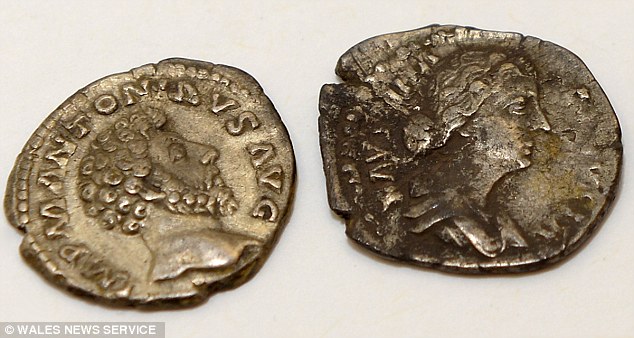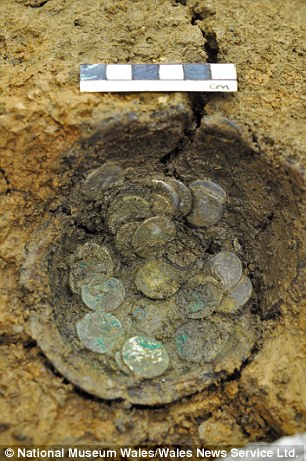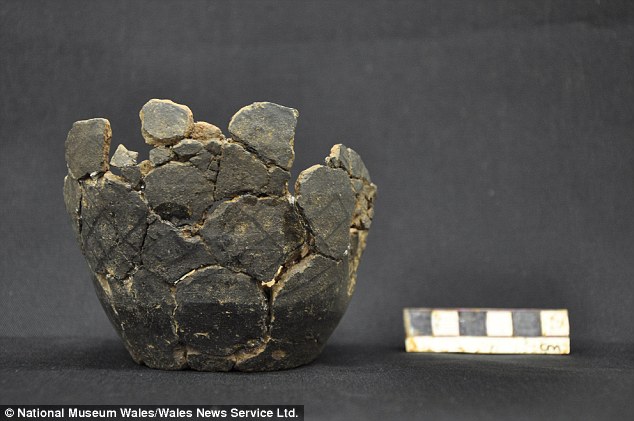A hoard of silver coins, some of which were issued by Roman general Mark Antony, has been discovered in a Welsh field more than 2,000 years after it was buried.
While they have yet to be valued, the 91 coins have been hailed by history experts as 'a significant find' and could be worth 'tens of thousands of pounds.'
The coins were issued by Roman rulers spanning 200 years, with the earliest dating back to when Mark Antony was general in 31BC, through to the rule of Emperor Nero between 54 and 68AD and Marcus Aurelius, who headed the Empire from 161AD to 180AD.
Hoard of Roman coins dating back to Mark Antony are discovered in Welsh field: 91 pieces of 2,000-year-old silver could be worth 'tens of thousands of pounds'
The hoard of 91 coins was found in Wick, Vale of Glamorgan, by two walkers
It has been declared treasure, but there is no official valuation yet
Oldest coins date back to 31 BC and were issued by general Mark Antony
Known for his relationship with Cleopatra and growth of Roman Empire
By Sarah Griffiths for MailOnline
26 November 2015
Daily Mail
A hoard of silver coins, some of which were issued by Roman general Mark Antony, has been discovered in a Welsh field more than 2,000 years after it was buried.
While they have yet to be valued, the 91 coins have been hailed by history experts as 'a significant find' and could be worth 'tens of thousands of pounds.'
The coins were issued by Roman rulers spanning 200 years, with the earliest dating back to when Mark Antony was general in 31BC, through to the rule of Emperor Nero between 54 and 68AD and Marcus Aurelius, who headed the Empire from 161AD to 180AD.

A hoard of coins (pictured), some of which were issued by Roman general Mark Antony, have been discovered in a Welsh field more than 2,000 years after they were buried

Mark Antony (83BC - 30BC) was a Roman politician and general who played a critical role in the transformation of the Roman Republic from an oligarchy into the autocratic Roman Empire
They were unearthed by two friends out walking in a field near the small village of Wick in the Vale of Glamorgan and, during the Roman era, each coin would have been the equivalent to a day's pay.
It is not known how, or when, they were brought to the region.
Consultant psychiatrist Dr Richard Annear, 65 and John Player, 43, came across the small pot containing the money, including three particularly old silver denarii.
They reported it to curators who were able to remove a chunk of soil containing the delicate find safely.
Three of the coins date from 31BC when they were issued by Roman general Mark Antony, who was a key ally of Julius Caesar and played a pivotal role in the growth of the Roman Empire.
It is not known how many coins were minted during the reigns of different Roman rulers, because while many were struck in Rome, provincial cities were also allowed to mint their own coins.
Mints were typically run by a magistrate or government representative and each coin was crafted by an artisan, according to University of California academics.
The design was carved on an apparatus called a 'die', while the metal or 'flan' for a coin would be measured and heated.
The die was then hit with a hammer to imprint the image on the coin, which explains why some of the faces on the coins are off-centre.
The rare hoard was discovered within a mile of another historic find of 130 denarii unearthed 15 years ago.

Three of the coins (pictured) date from 31BC when they were issued by Roman general Mark Antony, who was a key ally of Julius Caesar and played a pivotal role in the Roman Empire

The rare hoard was discovered within a mile from another historic find of 130 denarii, which was unearthed 15 years ago. This image shows a Marcus Aurelius coin from the newly-discovered hoard

Consultant psychiatrist Dr Richard Annear, 65, and John Player, 43, came across the small pot containing the money, including three particularly old silver denarii while walking in a field in Wick (marked on the map)
Assistant keeper at the National Museum of Wales Edward Besly said: 'Each coin represents about a day's pay at the time, so the hoard represents a significant sum of money.'
'The hoard's find spot is only a mile as the crow flies from that of another second century silver hoard found in 2000.
'Together the hoards point to a prosperous coin-using economy in the area in the middle of the second century.'
A numismatist has said the denarii may be 'worth tens of thousands of pounds'.
Senior Coroner Andrew Barkley ruled that the coins are 'treasure trove' at Cardiff Coroner's Court.


The pair reported the find to curators who were able to remove a chunk of soil containing the delicate find (pictured left and a close-up, right) safely

The three silver denarii were found among the 'new' hoard of 91 coins, including those issued by Roman rulers spanning 200 years. A selection from the Wick hoard are shown above

The items will now be taken to the Treasure Valuation Committee, in London, where they will be independently valued.
Mark Antony engaged in a passionate affair with queen of Egypt, Cleopatra after leaving his wife in Rome.
Their romance was made famous by Shakespeare's 1602 play and later immortalised in the 1963 Hollywood film Antony and Cleopatra, staring Richard Burton and Elizabeth Taylor.
But the pair's romance was short-lived and they allegedly both took their own lives after Antony lost the crucial Battle of Actium to Augustus - Rome's first emperor.

A numismatist has said the denarii may be 'worth tens of thousands of pounds'. A close-up of a coin bearing the image of Marcus Aurelius, which was among the hoard, is shown above
CHRONOLOGY OF THE COINS
The oldest coins among the hoard were issued by Roman general Mark Antony in 31BC.
He lived between January 14 83 BC and August 1 30 BC and was a Roman politician and general who played a critical role in the transformation of the Roman Republic to an autocratic Empire.
He is perhaps best known for his relationship with queen of Egypt, Cleopatra after leaving his wife in Rome.
The coins span 200 years of Roman history. Some of them date from the rule of Emperor Nero, between 54 and 68AD.
While Nero focused on enhancing cultural life in the Empire, he is known for being cruel and corrupt, having executed his mother and possibly murdered his brother.
It is even suggested that he started the Great Fire of Rome in 64 AD to make room for his palatial complex, the Domus Aurea.
The most recent coins among the hoard were issued by Marcus Aurelius, who ruled from 161AD to 180AD.
He was a great military leader and during his reign the Empire defeated a revitalised Parthian Empire in the east as well as winning other territories.
Marcus Aurelius was also a scholar and his literary work 'Meditations' is still revered as a monument to the philosophy of service and duty, describing how to find composure and remain calm in the midst of conflict.
WHO WAS MARK ANTONY? POLITICIAN, GENERAL AND FAMOUS LOVER
Marcus Antonius, or Marc Antony, lived between January 14 83 BC and August 1 30 BC.
He was a Roman politician and general who played a critical role in the transformation of the Roman Republic to an autocratic Empire.
He was a supporter of Julius Caesar, and served as one of his generals during the conquest of Gaul and the Civil War.

Antony and Cleopatra's romance was made famous by Shakespeare's 1602 play and later immortalised in the 1963 Hollywood film Antony and Cleopatra, staring Richard Burton and Elizabeth Taylor (pictured)
He was appointed administrator of Italy while Caesar eliminated political opponents in Greece, North Africa, and Spain and after Caesar's death, formed a three-man dictatorship known as the Second Triumvirate.
Carving up the Republic, Antony was assigned Rome's eastern provinces, including the client kingdom of Egypt, then ruled by Cleopatra.
Despite marrying Octavian's sister to avert civil war with the Triumvirs, Antony carried on an affair with Cleopatra, who bore him three children.
This strained the relationship with Octavian further and in 31BC, Antony was defeated by Octavian's forces at the Battle of Actium.
He fled to Egypt, where he and Cleopatra committed suicide.

Many of the coins were found inside this little pot, but it's not known why they were buried and never collected

Senior Coroner Andrew Barkley ruled that the coins are 'treasure trove' at Cardiff Coroner's Court. This image shows one of the oldest coins found, which was issued by Roman general Mark Antony
While they have yet to be valued, the 91 coins have been hailed by history experts as 'a significant find' and could be worth 'tens of thousands of pounds.'
The coins were issued by Roman rulers spanning 200 years, with the earliest dating back to when Mark Antony was general in 31BC, through to the rule of Emperor Nero between 54 and 68AD and Marcus Aurelius, who headed the Empire from 161AD to 180AD.
Hoard of Roman coins dating back to Mark Antony are discovered in Welsh field: 91 pieces of 2,000-year-old silver could be worth 'tens of thousands of pounds'
The hoard of 91 coins was found in Wick, Vale of Glamorgan, by two walkers
It has been declared treasure, but there is no official valuation yet
Oldest coins date back to 31 BC and were issued by general Mark Antony
Known for his relationship with Cleopatra and growth of Roman Empire
By Sarah Griffiths for MailOnline
26 November 2015
Daily Mail
A hoard of silver coins, some of which were issued by Roman general Mark Antony, has been discovered in a Welsh field more than 2,000 years after it was buried.
While they have yet to be valued, the 91 coins have been hailed by history experts as 'a significant find' and could be worth 'tens of thousands of pounds.'
The coins were issued by Roman rulers spanning 200 years, with the earliest dating back to when Mark Antony was general in 31BC, through to the rule of Emperor Nero between 54 and 68AD and Marcus Aurelius, who headed the Empire from 161AD to 180AD.

A hoard of coins (pictured), some of which were issued by Roman general Mark Antony, have been discovered in a Welsh field more than 2,000 years after they were buried

Mark Antony (83BC - 30BC) was a Roman politician and general who played a critical role in the transformation of the Roman Republic from an oligarchy into the autocratic Roman Empire
They were unearthed by two friends out walking in a field near the small village of Wick in the Vale of Glamorgan and, during the Roman era, each coin would have been the equivalent to a day's pay.
It is not known how, or when, they were brought to the region.
Consultant psychiatrist Dr Richard Annear, 65 and John Player, 43, came across the small pot containing the money, including three particularly old silver denarii.
They reported it to curators who were able to remove a chunk of soil containing the delicate find safely.
Three of the coins date from 31BC when they were issued by Roman general Mark Antony, who was a key ally of Julius Caesar and played a pivotal role in the growth of the Roman Empire.
It is not known how many coins were minted during the reigns of different Roman rulers, because while many were struck in Rome, provincial cities were also allowed to mint their own coins.
Mints were typically run by a magistrate or government representative and each coin was crafted by an artisan, according to University of California academics.
The design was carved on an apparatus called a 'die', while the metal or 'flan' for a coin would be measured and heated.
The die was then hit with a hammer to imprint the image on the coin, which explains why some of the faces on the coins are off-centre.
The rare hoard was discovered within a mile of another historic find of 130 denarii unearthed 15 years ago.

Three of the coins (pictured) date from 31BC when they were issued by Roman general Mark Antony, who was a key ally of Julius Caesar and played a pivotal role in the Roman Empire

The rare hoard was discovered within a mile from another historic find of 130 denarii, which was unearthed 15 years ago. This image shows a Marcus Aurelius coin from the newly-discovered hoard

Consultant psychiatrist Dr Richard Annear, 65, and John Player, 43, came across the small pot containing the money, including three particularly old silver denarii while walking in a field in Wick (marked on the map)
Assistant keeper at the National Museum of Wales Edward Besly said: 'Each coin represents about a day's pay at the time, so the hoard represents a significant sum of money.'
'The hoard's find spot is only a mile as the crow flies from that of another second century silver hoard found in 2000.
'Together the hoards point to a prosperous coin-using economy in the area in the middle of the second century.'
A numismatist has said the denarii may be 'worth tens of thousands of pounds'.
Senior Coroner Andrew Barkley ruled that the coins are 'treasure trove' at Cardiff Coroner's Court.


The pair reported the find to curators who were able to remove a chunk of soil containing the delicate find (pictured left and a close-up, right) safely

The three silver denarii were found among the 'new' hoard of 91 coins, including those issued by Roman rulers spanning 200 years. A selection from the Wick hoard are shown above

The items will now be taken to the Treasure Valuation Committee, in London, where they will be independently valued.
Mark Antony engaged in a passionate affair with queen of Egypt, Cleopatra after leaving his wife in Rome.
Their romance was made famous by Shakespeare's 1602 play and later immortalised in the 1963 Hollywood film Antony and Cleopatra, staring Richard Burton and Elizabeth Taylor.
But the pair's romance was short-lived and they allegedly both took their own lives after Antony lost the crucial Battle of Actium to Augustus - Rome's first emperor.

A numismatist has said the denarii may be 'worth tens of thousands of pounds'. A close-up of a coin bearing the image of Marcus Aurelius, which was among the hoard, is shown above
CHRONOLOGY OF THE COINS
The oldest coins among the hoard were issued by Roman general Mark Antony in 31BC.
He lived between January 14 83 BC and August 1 30 BC and was a Roman politician and general who played a critical role in the transformation of the Roman Republic to an autocratic Empire.
He is perhaps best known for his relationship with queen of Egypt, Cleopatra after leaving his wife in Rome.
The coins span 200 years of Roman history. Some of them date from the rule of Emperor Nero, between 54 and 68AD.
While Nero focused on enhancing cultural life in the Empire, he is known for being cruel and corrupt, having executed his mother and possibly murdered his brother.
It is even suggested that he started the Great Fire of Rome in 64 AD to make room for his palatial complex, the Domus Aurea.
The most recent coins among the hoard were issued by Marcus Aurelius, who ruled from 161AD to 180AD.
He was a great military leader and during his reign the Empire defeated a revitalised Parthian Empire in the east as well as winning other territories.
Marcus Aurelius was also a scholar and his literary work 'Meditations' is still revered as a monument to the philosophy of service and duty, describing how to find composure and remain calm in the midst of conflict.
WHO WAS MARK ANTONY? POLITICIAN, GENERAL AND FAMOUS LOVER
Marcus Antonius, or Marc Antony, lived between January 14 83 BC and August 1 30 BC.
He was a Roman politician and general who played a critical role in the transformation of the Roman Republic to an autocratic Empire.
He was a supporter of Julius Caesar, and served as one of his generals during the conquest of Gaul and the Civil War.

Antony and Cleopatra's romance was made famous by Shakespeare's 1602 play and later immortalised in the 1963 Hollywood film Antony and Cleopatra, staring Richard Burton and Elizabeth Taylor (pictured)
He was appointed administrator of Italy while Caesar eliminated political opponents in Greece, North Africa, and Spain and after Caesar's death, formed a three-man dictatorship known as the Second Triumvirate.
Carving up the Republic, Antony was assigned Rome's eastern provinces, including the client kingdom of Egypt, then ruled by Cleopatra.
Despite marrying Octavian's sister to avert civil war with the Triumvirs, Antony carried on an affair with Cleopatra, who bore him three children.
This strained the relationship with Octavian further and in 31BC, Antony was defeated by Octavian's forces at the Battle of Actium.
He fled to Egypt, where he and Cleopatra committed suicide.

Many of the coins were found inside this little pot, but it's not known why they were buried and never collected

Senior Coroner Andrew Barkley ruled that the coins are 'treasure trove' at Cardiff Coroner's Court. This image shows one of the oldest coins found, which was issued by Roman general Mark Antony
Last edited:
